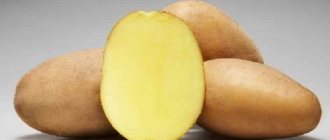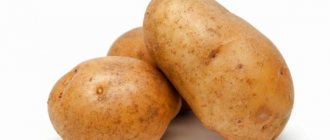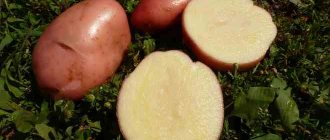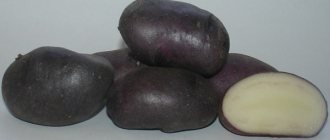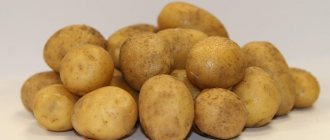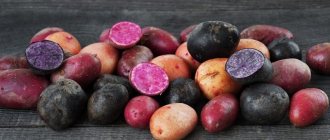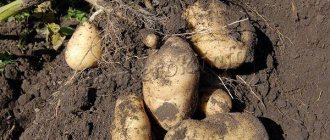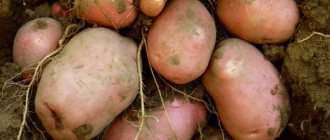Anniversary of Zhukov
General characteristics: mid-early table variety of Russian selection with oval tubers.
Easy to care for and stores well. Ripening period (vegetation): 65-80 days.
Starch content: 10.1-13.5%.
Weight of commercial tubers (grams): 64-139.
Number of tubers in a bush: 7-12 pieces.
Productivity (c/ha): 206-238 (maximum – 424).
Consumer qualities: good taste, culinary type AB, suitable for preparing salads, soups, frying and baking.
Keeping quality (storage ability): 98%.
Peel color: yellow.
Flesh color: white.
Preferred growing regions (RF): Central.
Disease resistance: the variety is resistant to potato cancer, common scab and Alternaria blight. It is affected by late blight of tops and tubers, and golden cyst nematode.
Features of cultivation: standard agricultural technology.
Other: the originator of the potato variety “Zhukov’s Jubilee” is VNIIKH named after. A. G. Lorkha (Russia).
Landing
Potatoes Jubilee Zhukov are planted from the end of April, in the first half of May. An important condition is that the soil warms up to 12 degrees (recurrent frosts must stop).
The seed material is reviewed and damaged potatoes are discarded. The tubers are pre-soaked for 30-40 minutes in 1% potassium permanganate, Fitosporin. Fungicides used are Acrobat and Fundazol. To stimulate, potatoes are sprayed with Epin, Poteytin, Kornevin.
The layout is 30 by 60 cm, planting density is 4-5 bushes per 1 m2. The holes are dug to a depth of 7-10 cm, in the sand to a depth of 12-15 cm. 15 g of Kemira or nitrophoska, a handful of rotted plant organic matter, 1 tbsp. l. superphosphate.
Description of the potato variety Jubilee Zhukov
Characteristics of the potato variety Yubilei Zhukov.
Originator: VNIIKH im. A. G. Lorkha.
Mid-early potato variety, suitable for table use. The taste is good.
Plant of medium height, intermediate type, semi-erect. Medium sized leaf, green. The leaf is small, narrow. The undulation of the edge is weak. The inflorescence is small. The corolla is small and white.
The tuber is oval, with small eyes. The peel is smooth to medium rough, yellow. The pulp is white. The weight of the commercial tuber is 64-139 g. The starch content is 10.1-13.5%, at the standard level.
The variety is resistant to the potato canker pathogen and susceptible to the golden potato cyst nematode. Susceptible to late blight on tops, moderately susceptible on tubers. According to the originator, it is resistant to common scab and Alternaria.
The marketable yield of the Yubilei Zhukov potato variety is 206-238 c/ha, at the level and 34 c/ha higher than the Nevsky standard. The maximum yield is 424 c/ha, 173 c/ha above the standard (Vladimir region). Marketability 87-98%, at the standard level. Keeping quality 98%.
The value of the variety: high yield, marketability, keeping quality of tubers, their resistance to mechanical damage.
The variety is included in the State Register for the Central region.
Description of Zhukovsky early potatoes
The plant forms low, semi-compact bushes with many branching shoots. The leaves are dissected, small in size, intense green in color. The leaf plates are dotted with relief veins.
Zhukovsky blooms profusely, but the flowering period is very short. After the end of the flowering phase, it does not form green fruits on peduncles. The inflorescences are small in size, but very dense. The petals are painted in purple-pink tones, with a white border along their edge.
The appearance of the tubers is oval-round, with good commercial qualities. The tubers are medium in size, their weight is 100-150 g. The integumentary shell of the tubers is pink and has no roughness. The eyes are small, red, and shallow-lying. The pulp is white, tastes slightly sweet, and does not darken when cooked. The texture of the fruit is dense.
According to the estimated characteristics, early Zhukovsky potatoes have the following indicators:
- marketability of tubers – 92%;
- degree of safety – 96%;
- resistance to drought and cold – increased;
- ripening period – early (60 days);
- resistance to mechanical stress;
- The yield of tubers from one bush can be 15 pieces.
Potatoes Jubilee Zhukova description of variety photo reviews
Buy potato seeds Seed Jubilee Zhukov (2 kg) Mid-early variety for table use. The plant is semi-erect, of medium height, the color of the flowers is white. The tubers are oval-shaped, the peel is yellow, the pulp is white, the weight of the marketable tuber is 70-140g. Productivity is good, marketability is 87-98%, keeping quality is 98%, starch content is up to 14%. Resistant to cancer, relatively resistant to scab, moderately resistant to late blight.
Related article: Potato variety “Manitou” - description and photo
Value of the variety: high content of antioxidants, stable yield, good taste, resistance of tubers to mechanical damage, good keeping quality.
Source: 1semena. ru
Potato is a daredevil
Source: Semenopt. com
Advantages and disadvantages
Pros:
- early maturity and productivity;
- good keeping quality;
- adaptability to different climates;
- low susceptibility to infections;
- unpretentiousness during cultivation;
- excellent taste;
- suitable for sales at the early vegetable market;
- tolerance to temperature changes;
- stable yield indicators.
Minuses:
- late blight attacks are possible during an epidemic, as well as pest invasions (Colorado beetles, wireworms);
- there is a risk of nematode infection.
Reader's experience: potato varieties that have proven to be better than others
For several generations, potatoes have been a favorite crop in our family. And since childhood I helped plant, hill up and harvest it, and over time I fell in love with growing potatoes.
Every year I plant a lot of potatoes of different varieties - both for food and to feed livestock. Since each variety is unique, I carefully monitor the plants from planting to harvesting. Of course, I definitely evaluate the harvest by quality and storage ability. Can ash cause scab infection in potatoes?
I can say that the most dangerous enemies of potatoes are the Colorado potato beetle and late blight. But if it is possible to fight the “minke”, then late blight is a very bad disease, and drugs do not cope well with it. Therefore, the resistance of the variety to it is very important.
I first planted this variety about 10 years ago. In the first year, he surprised with the lush growth of the tops: by mid-summer it stood like a powerful wall, and during flowering the area turned into a miracle - a white cloud on a green background. Its tops are not very afraid of late blight and retain their vigor and color until late autumn. When dug up, the variety annually and consistently produces a good harvest of yellow-skinned tubers: there are up to 20–25 large potatoes under the bush. Harvesting such a harvest is a pleasure! True, the tubers still suffer from late blight and it is better to dig up the crop early, otherwise there will be a lot of losses during storage. The taste of the variety is good, the flesh is white, and crumbles when cooked.
He settled on my property not so long ago, but quickly began to compete with the Sorcerer. The variety immediately proved itself to have good yield: under each bush I find on average about 18–20 oval tubers. You cook it and the white flesh crumbles on the plate and shines like snow. Among the disadvantages is low resistance to late blight. How to properly harvest and store early potatoes for seeds?
The summer of 2021 was hot and dry, and at the end of August the weather worsened sharply and there were prolonged rains. However, Irbitsky still rewarded us with a good harvest. From the moment of planting, the variety was distinguished by powerful and vigorous growth, and later bloomed profusely. Because of the weather, we had to hurry with the harvesting (we dug on the 20th of August), but the tops were still green. Large pink tubers rolled out of the soil like balls! There were not many of them under the bush, from 5 to 8 pieces, but five medium-sized tubers weighed 2 kg. The cut potatoes do not have voids and are poorly cooked.
Article on the topic: Potato variety Skarb - description and photo
These varieties have spectacular tubers with red skin. At least for the display case - even and beautiful. Although the potatoes were medium in size, there were a lot of them under each bush.
Features of care
Zhukovsky is also easy to care for. It is important to hill it regularly, water it as needed and remove weeds. Feeding is practically not needed.
Watering
Moderate watering is required. Usually the weather conditions are sufficient. But if it’s a hot and dry year, then Zhukovsky potatoes need to be watered every week. It is advisable to organize drip irrigation.
Hilling
Hilling plays an important role in growing potatoes. You need to start immediately after germination. Cover them with earth so that they are not visible. This stimulates the development of the root system and protects from bad weather. Then, when the sprouts grow 10-15 cm, hill them a second time. When the stems grow a little more and elongate, additional hilling will help stimulate the formation of new tubers.
Hilling should also be done after watering or the day after rain to retain moisture in the soil. Look at the rules for hilling potatoes.
The best time for hilling is morning or evening; the sun is too bright in the middle of the day.
Feeding
Potatoes respond well to fertilizing. You need to fertilize 2-3 times per season. Apply the first portion after germination. A solution of wood ash, bird droppings or compost is suitable. Pour half a bucket under the bush. Next you need to hill up the potatoes. Ready-made potash fertilizers and superphosphates are also suitable. By the way, there is a detailed article about when and what to feed potatoes.
The second time is fed during flowering.
And the third during fruit setting. At this time, it is more important to apply potassium fertilizers. But there is no need to overdo it with fertilizing.
If the soils are initially fertile and a lot of nutrients were added during preparation, then additional fertilizing is not needed.
Loosening and killing weeds
Loosening and removing weeds is an important part of care. These procedures help saturate the soil with oxygen, which promotes the development of roots and fruits. They also protect against pests and diseases.
Reader's experience: potato varieties that have proven to be better than others
For several generations, potatoes have been a favorite crop in our family. And since childhood I helped plant, hill up and harvest it, and over time I fell in love with growing potatoes.
Every year I plant a lot of potatoes of different varieties - both for food and to feed livestock. Since each variety is unique, I carefully monitor the plants from planting to harvesting. Of course, I definitely evaluate the harvest by quality and storage ability.
I can say that the most dangerous enemies of potatoes are the Colorado potato beetle and late blight. But if it is possible to fight the “minke”, then late blight is a very bad disease, and drugs do not cope well with it. Therefore, the resistance of the variety to it is very important.
Sorcerer
I first planted this variety about 10 years ago. In the first year, he surprised with the lush growth of the tops: by mid-summer it stood like a powerful wall, and during flowering the area turned into a miracle - a white cloud on a green background. Its tops are not very afraid of late blight and retain their vigor and color until late autumn. When dug up, the variety annually and consistently produces a good harvest of yellow-skinned tubers: there are up to 20–25 large potatoes under the bush. Harvesting such a harvest is a pleasure! True, the tubers still suffer from late blight and it is better to dig up the crop early, otherwise there will be a lot of losses during storage. The taste of the variety is good, the flesh is white, and crumbles when cooked.
Anniversary of Zhukov
He settled on my property not so long ago, but quickly began to compete with the Sorcerer. The variety immediately proved itself to have good yield: under each bush I find on average about 18–20 oval tubers. You cook it and the white flesh crumbles on the plate and shines like snow. Among the disadvantages is low resistance to late blight.
Irbitsky
The summer of 2021 was hot and dry, and at the end of August the weather worsened sharply and there were prolonged rains. However, Irbitsky still rewarded us with a good harvest. From the moment of planting, the variety was distinguished by powerful and vigorous growth, and later bloomed profusely. Because of the weather, we had to hurry with the harvesting (we dug on the 20th of August), but the tops were still green. Large pink tubers rolled out of the soil like balls! There were not many of them under the bush, from 5 to 8 pieces, but five medium-sized tubers weighed 2 kg. The cut potatoes do not have voids and are poorly cooked.
Related article: Potato variety “Kiebitz” - description and photo
Lux and Lighthouse
These varieties have spectacular tubers with red skin. At least for the display case - even and beautiful. Although the potatoes were medium in size, there were a lot of them under each bush.
Diseases and pests
Zhukovsky is resistant to most dangerous diseases. But it can be affected by late blight and the main potato pest, the Colorado potato beetle.
The best way to fight is prevention. Plant only tested and uninfected material. To protect yourself from late blight, perform crop rotation more often. It is also recommended to mow the tops of potatoes a couple of weeks before harvesting.
Late blight of potatoes
You can determine what ails potatoes in an article about potato diseases with photos, descriptions and treatment options.
You can fight the beetle using traditional methods and chemicals. The first include the following measures:
- collecting beetles by hand;
- dusting with cornmeal. It swells in the insect's stomach and causes its death. The number of pests is reduced;
- sprinkling with plaster, ash, tobacco, cement. All these substances are extremely unpleasant for beetles. Plus the larvae die.
You can also use insecticides, but this must be done before flowering, and especially not during fruit formation.
